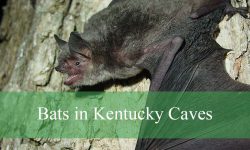Crickets are a familiar soundscape across Texas, filling warm evenings with their distinctive chirps. These insects play vital roles in local ecosystems, serving as both pest controllers and prey for many animals. Understanding the types of crickets that call Texas home can deepen your appreciation for these fascinating creatures.
From the robust Texas Field Cricket to the delicate Texas Tree Cricket, each species has unique features and behaviors that set them apart. Whether you’re an avid naturalist or simply curious about the nighttime chorus, learning to identify these crickets enhances your outdoor experience.
In this guide, we explore seven common cricket species found in Texas, complete with detailed descriptions and photos to help you recognize each one. Dive into the world of Texas crickets and discover what makes them such interesting members of the insect community.
Common Crickets Found in Texas
Texas Field Cricket (Gryllus texensis)
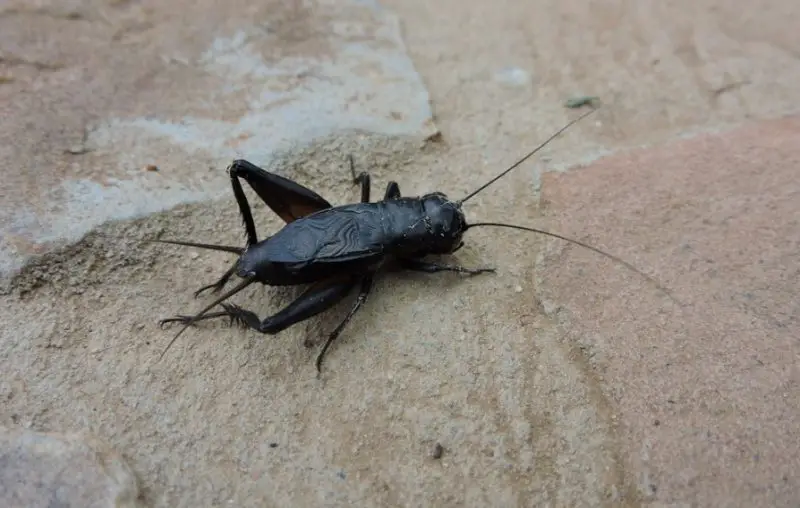
The Texas Field Cricket is a large and robust cricket species native to Texas and surrounding areas. It has a shiny black or very dark brown body with a tough exoskeleton. Adults typically measure between 1 to 1.5 inches (25 to 38 mm) in length. Their long, threadlike antennae often exceed the length of their body, helping them detect environmental cues. The legs are strong and adapted for jumping, while the forewings are hardened to produce sound.
Males are known for their loud, rhythmic chirping calls which they create by rubbing the serrated edges of their forewings together—a process called stridulation. These calls serve to attract females and establish territories, especially during the warm months of spring and summer. The chirps have a steady tempo and are easily heard at night, sometimes resembling a repetitive “tick-tick-tick” pattern. Female Texas Field Crickets lack the sound-producing structures and remain silent.
This species prefers open grassy habitats such as meadows, fields, pastures, and lawns. During the day, Texas Field Crickets tend to hide beneath rocks, logs, or dense vegetation to avoid predators and harsh sunlight. They are mostly nocturnal, becoming active after dusk. Their diet is omnivorous, feeding on plant material, decaying organic matter, and small insects, which makes them important for nutrient recycling and natural pest control.
Ecologically, Texas Field Crickets play an essential role as prey for a variety of predators, including birds, reptiles, amphibians, and small mammals. Their burrowing behavior helps aerate the soil, promoting healthier plant growth. In addition to their natural habitats, they are sometimes used as feeder insects in the pet trade due to their size and easy rearing.
Carolina Ground Cricket (Eunemobius carolinus)
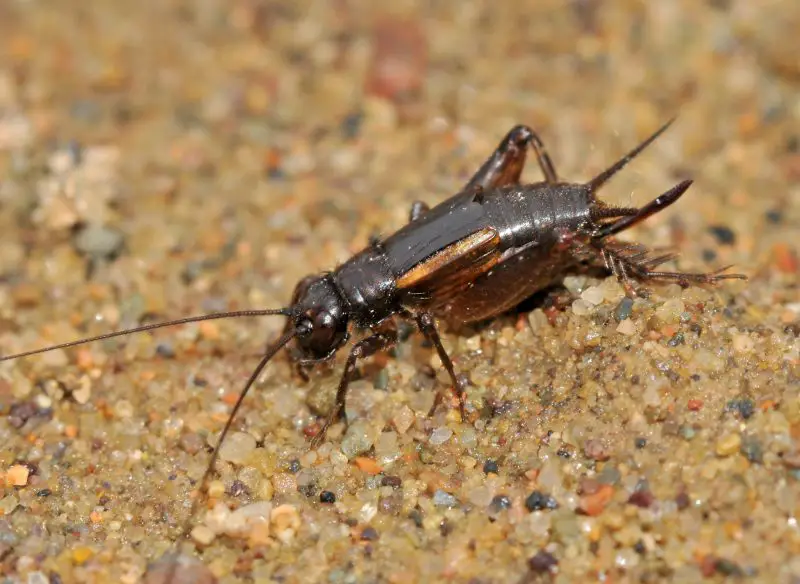
The Carolina Ground Cricket is smaller and more inconspicuous than the Texas Field Cricket. Adults usually range from 0.5 to 0.75 inches (13 to 19 mm) in length and have a light brown to tan coloration mottled with darker patches. Their compact, slender bodies are well-camouflaged against soil, leaf litter, and decomposing vegetation, which form their primary habitat. The antennae are long and sensitive, assisting in navigation and detecting threats in their environment.
Unlike the louder and more aggressive Texas Field Cricket, the Carolina Ground Cricket produces a much softer and less frequent call. Their chirping is a delicate, high-pitched trill that usually occurs during the early evening or warm months when temperatures are favorable. Males use their calls primarily to attract mates, but due to the low volume, they are less easily heard by humans. The females do not produce calls.
Carolina Ground Crickets prefer sandy, loose soils found at the edges of woodlands, grassy fields, gardens, and other semi-open areas. They spend much of their time hidden under leaf litter, fallen logs, or loose soil during daylight hours. Their diet consists largely of decaying plant matter and fungi, which makes them important decomposers contributing to nutrient cycling in their ecosystems.
Behaviorally, this species is less mobile and less likely to jump long distances compared to field crickets. Their relatively secretive nature and small size make them less commonly noticed by people. They serve as prey for small predators such as spiders, ground beetles, and small reptiles, playing a quiet yet vital role in the balance of their habitat.
House Cricket (Acheta domesticus)
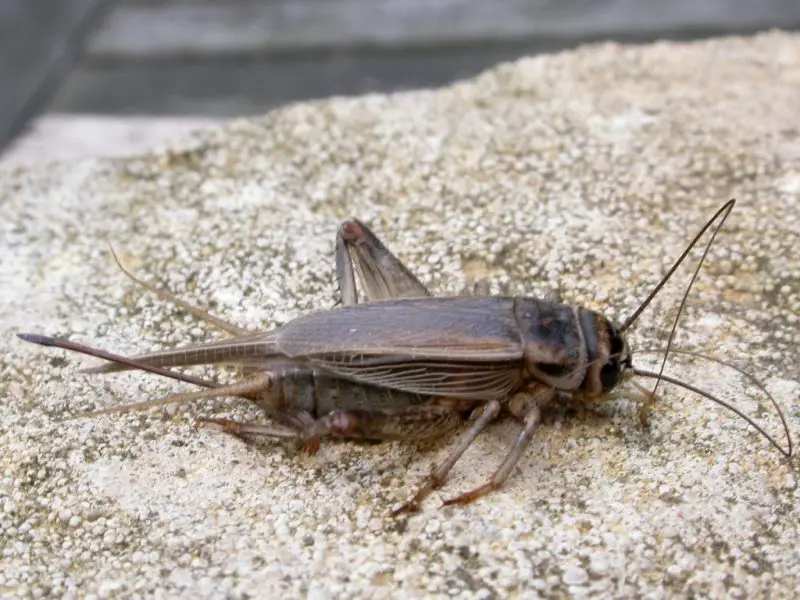
The House Cricket is a widely distributed species often associated with human environments throughout Texas. Adults are approximately 1 inch (25 mm) in length with a light tan to pale brown body. Their most distinctive feature is the three dark longitudinal stripes running from the head down the pronotum (the shield-like structure behind the head). The body is robust and rounded with well-developed hind legs for jumping.
Male House Crickets are famous for their loud and continuous chirping calls, which can often be heard indoors or near buildings at night. Their song consists of rapid pulses repeated in a steady rhythm, used to attract females and communicate with rivals. Females lack the sound-producing wings and remain silent. The frequency of their calls often increases with temperature, making them especially vocal on warm nights.
House Crickets thrive in sheltered environments such as basements, crawl spaces, sheds, barns, and other human-made structures. They can also live outdoors in protected areas with abundant food and shelter. Their diet is highly adaptable, including plant materials, food scraps, fabric, and even dead insects, which sometimes leads them to be considered minor pests in homes.
Despite their pest potential, House Crickets are widely bred commercially as live feed for pets like reptiles, amphibians, and birds. Their ability to thrive indoors and near human habitation makes them one of the most familiar cricket species in Texas. They are mostly nocturnal and seek moisture and warmth to survive, often clustering near water sources.
Mormon Cricket (Anabrus simplex)
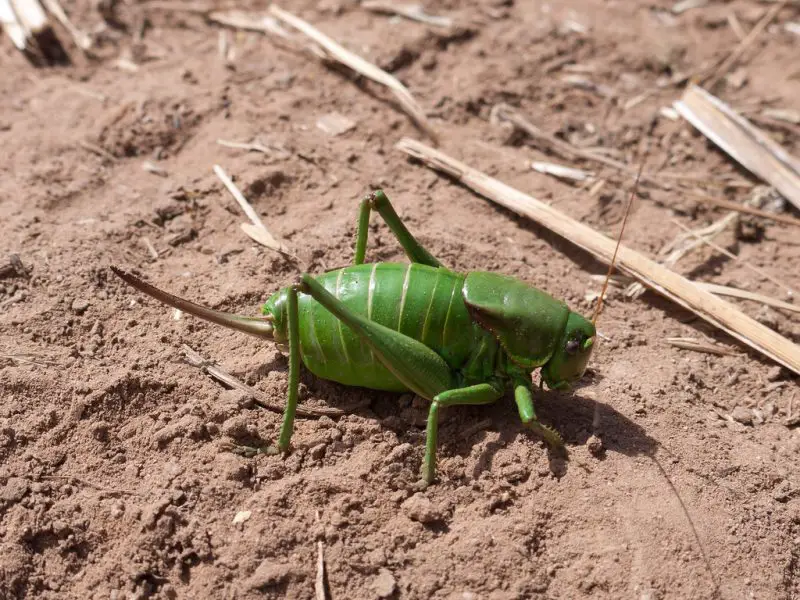
The Mormon Cricket, although technically a katydid rather than a true cricket, is a notable insect species found in parts of Texas, especially in drier, arid regions. It is quite large compared to typical crickets, growing up to 2 inches (50 mm) in length. Its body is wingless and robust, with a brown to gray coloration that blends well into dry grasslands and desert-like habitats. The head is dark and distinct, and powerful hind legs enable strong jumping capabilities.
Mormon Crickets are famous for their occasional swarming behavior, where large groups move en masse across the landscape. These swarms can number in the thousands and travel together, sometimes causing significant damage to crops and native vegetation. They feed mainly on grasses, crops, and other green plant matter. Unlike many crickets, Mormon Crickets are primarily active during the day, making them more visible to observers.
Their calls are less musical and more of a rasping or clicking sound, produced when males rub their hind legs against the sides of their bodies. However, their vocalizations are not as prominent or melodic as those of other cricket species. This katydid’s ability to travel long distances by walking and jumping aids in their foraging and swarming behavior.
Mormon Crickets prefer open, dry environments such as plains, grasslands, and shrublands common in western Texas. Their large size and swarming nature make them a unique ecological player. While they can be pests to agriculture, they also serve as food for many predators and contribute to the food web in their ecosystems.
Texas Tree Cricket (Oecanthus texanus)

The Texas Tree Cricket is a slender, delicate insect often found in trees, shrubs, and gardens throughout Texas. Its body is typically pale green to yellowish, which allows it to blend seamlessly with leaves and stems. Adults measure about 0.75 to 1 inch (19 to 25 mm) long, with long, fine antennae that help it sense its surroundings. Unlike many ground-dwelling crickets, the Texas Tree Cricket is adapted for an arboreal lifestyle, often resting on vegetation.
Male Texas Tree Crickets are famous for their continuous, high-pitched, and musical chirping that sounds like a steady “rreee-rreee” or “tick-tick” repeated rapidly. This sound is produced by rubbing their forewings together and serves to attract females. Their calls are especially prominent during warm nights in spring and summer, often heard near porches, gardens, and wooded areas. The intensity and tempo of their song can change with temperature.
This species prefers habitats rich in vegetation such as trees, bushes, and garden plants where it feeds primarily on plant sap, nectar, and small insects. Because of their feeding habits, Texas Tree Crickets can sometimes cause minor damage to plants by creating holes or weakening stems, but they generally do not pose significant threats to gardens.
Texas Tree Crickets are mostly nocturnal and well camouflaged during the day, making them hard to spot despite their loud calls at night. They play an ecological role by feeding on smaller insects and acting as prey for birds and spiders, contributing to the balance of the garden and woodland ecosystems in Texas.
Scudder’s Bush Cricket (Phyllopalpus pulchellus)
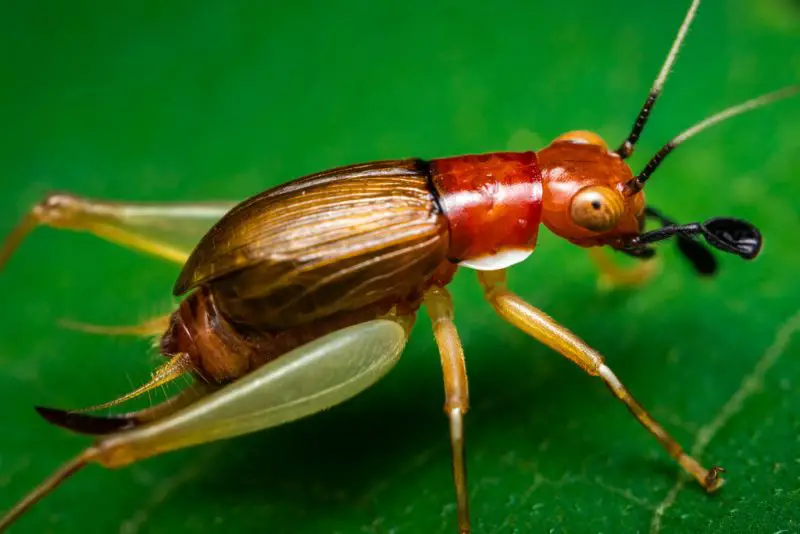
Scudder’s Bush Cricket is a medium-sized cricket species that stands out with its reddish-brown coloration and distinctive white markings on its wings and body. Adults range from about 0.8 to 1 inch (20 to 25 mm) in length. Their bodies are somewhat flattened with long legs and antennae, adaptations that help them navigate through grasses and low shrubs in their preferred habitats.
This cricket produces a unique call that closely resembles the sound of a cicada or katydid rather than the typical cricket chirp. The song is a rapid, buzzing trill that can be heard during the warmer months, primarily in the evenings. Males use these calls to establish territories and attract females. Their vocalizations are quite distinctive, making them easier to identify by sound than by sight.
Scudder’s Bush Cricket typically inhabits grasslands, meadows, and bushy areas where they can hide among dense vegetation. They are often found in eastern and central Texas, favoring areas with tall grasses and shrubs. Their diet consists of small insects and plant material, making them omnivores that contribute to controlling pest populations.
Behaviorally, these crickets are mostly nocturnal, seeking shelter during the day beneath leaves or in grass tussocks. Their cryptic coloration helps them avoid predators such as birds, spiders, and small mammals. Despite being less commonly noticed, Scudder’s Bush Crickets play an important role in their ecosystems by aiding in insect population control and serving as prey for larger animals.
Southern Wood Cricket (Nemobius fasciatus)
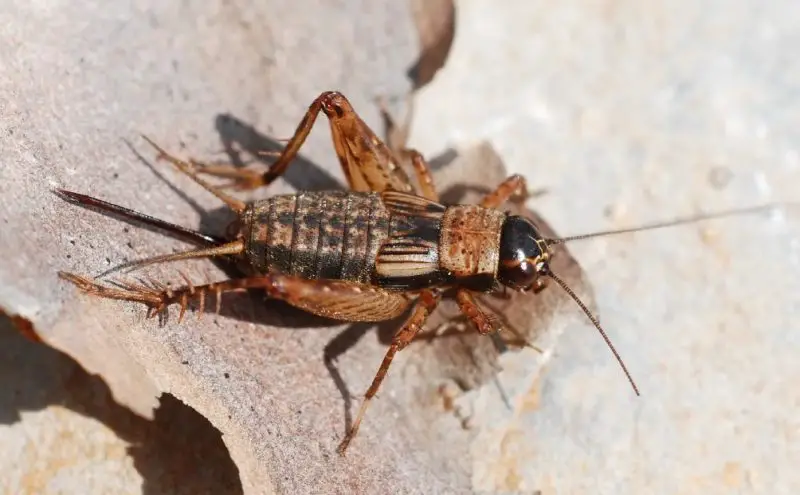
The Southern Wood Cricket is a small, shy species commonly found in wooded and forested areas of Texas. Adults measure approximately 0.5 to 0.7 inches (12 to 18 mm) long and have a dark brown to black body with subtle lighter bands or spots that help them blend into the leaf litter and decaying wood where they live. Their bodies are slender and somewhat flattened, adapted for hiding in narrow spaces.
Their calling song is a series of short, soft, and evenly spaced chirps, which males produce primarily during the evening and nighttime hours. Unlike louder field crickets, the Southern Wood Cricket’s call is gentle and less persistent, often described as a quiet “tick-tick-tick” repeated rhythmically. This subtle call helps males attract females while avoiding detection by predators.
Southern Wood Crickets prefer moist, shaded environments such as hardwood forests, woodland floors, and areas with abundant leaf litter and fallen branches. They spend much of their time hidden under logs, bark, or leaves and are seldom seen in open areas. Their diet mainly includes decaying plant material, fungi, and small invertebrates, contributing to nutrient recycling within forest ecosystems.
Behaviorally, these crickets are secretive and slow-moving, relying on camouflage and hiding rather than jumping or fleeing. They play an important ecological role as decomposers and as prey for various woodland predators, including birds, amphibians, and small mammals. Their presence indicates a healthy, undisturbed forest floor habitat.
FAQs about Crickets in Texas
What types of crickets are commonly found in Texas?
Texas is home to several cricket species, including the Texas Field Cricket, Carolina Ground Cricket, House Cricket, Mormon Cricket, Texas Tree Cricket, Scudder’s Bush Cricket, and Southern Wood Cricket. Each species has unique characteristics and habitats ranging from grassy fields and woodlands to human dwellings.
How can I identify a Texas Field Cricket?
Texas Field Crickets are large, shiny black or dark brown crickets measuring about 1 to 1.5 inches long. They have long antennae and produce loud, rhythmic chirping sounds at night. They are often found in open grassy areas like fields and lawns.
Do crickets make noise all year round in Texas?
Most cricket species in Texas are active and produce their characteristic chirping calls mainly during the warmer months of spring and summer. Their calling behavior decreases in cooler seasons when they become less active or enter a state of dormancy.
Are crickets harmful to my garden or home?
Generally, crickets are not harmful and can actually benefit gardens by feeding on pest insects and helping decompose organic matter. However, some species like the House Cricket may become minor pests indoors by feeding on fabrics or stored food. Texas Tree Crickets can sometimes cause minor damage to plants.
What do crickets in Texas eat?
Crickets are mostly omnivorous. They feed on plant material, small insects, decaying organic matter, fungi, and nectar depending on the species. For example, Texas Field Crickets eat plants and insects, while Carolina Ground Crickets focus on decaying plant material.
Where do crickets live in Texas?
Crickets inhabit a variety of environments across Texas. Field crickets prefer open grassy areas, ground crickets dwell in leaf litter and sandy soils, house crickets live near or inside human structures, and tree crickets stay in trees and shrubs. Some, like the Mormon Cricket, are found in arid, open lands.
Why do crickets chirp at night?
Male crickets chirp by rubbing their forewings together to attract females and establish territory. The chirping is most noticeable at night when they are most active and when sound travels better in cooler air. Different species have distinct chirping patterns and frequencies.
Can crickets be beneficial to the ecosystem?
Yes, crickets play important ecological roles. They serve as prey for many animals such as birds, reptiles, and mammals. They also help with decomposition by feeding on dead plant matter and pests, contributing to nutrient cycling and soil health.
How can I reduce cricket noise if it becomes bothersome?
If cricket chirping is disturbing, reducing outdoor lighting at night can help since light attracts crickets. Sealing cracks and gaps around your home prevents house crickets from entering. Using natural predators like birds or installing sound barriers can also reduce noise levels.


